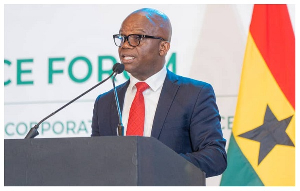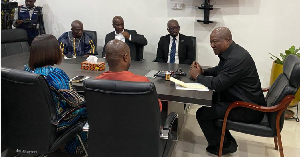Kenneth Kponor - NCCE
This article seeks to throw light on the justification of establishing this Authority and the benefits that will accrue to the people of this area and the nation.
In the 2010 Budget Statement and Economic Policy of the Government of Ghana presented to Parliament on the 18th November 2009, the Ministry of Water Resources, Works and Housing budgeted for the establishment of the KETA BASIN DEVELOPMENT AUTHORITY.
The authority is to manage the resources of the Keta Basin and Sea Defence project. This is contained in section 344 page 311 of the 2010 National Budget.
The creation of the Authority will bring together all past, present and future development initiatives under one umbrella for effective coordination and implementation for the benefit of the five administrative districts of the South Eastern Volta.
The proposal here is that this can be done through project interventions that restore productivity of agriculture, fisheries, industry through provision of road, electricity, health and educational infrastructure.
The Keta Lagoon Basin comprises a unique agro-ecological and climatic zone which borders with the Lower Volta River Estuary, the Atlantic sea as well as five administrative Districts in the southern Volta Region namely; Keta Municipality , Ketu North District, Ketu South District, Akatsi District and South Tongu District.
The total population in the basin is close to six hundred thousand people. The Basin is dominated by open lagoons, rivers, creeks and swamp lands which are subject to periodic inundation. Among the large water bodies that form the basin complex are Keta Lagoon, Avu Lagoon, Angor Lagoon and the waters of the Lower Volta River estuary.
Together these water bodies form the largest natural lagoon water body in Ghana and cover an area of 300km2, stretching 40km along the coast and acting as a reservoir for the flood waters of the Lower Volta River as well as major rivers flowing from Central Volta Region such as River Tordze, Nuyi, Belikpa and Aklikpa.
The lagoons are separated from the sea along much of its coastal length by a sand bar referred to as the coastal littoral. However at its western end the lagoon complex is joined to the sea through the Lower Volta Estuary and therefore subject to the daily and seasonal tidal regimes of the sea.
The Basin is located between the geographic coordinates of longitudes 0°30’E and 1°15’E and latitudes 5°45’N and 6°N and forms a unique ecological point for development. It is home to a Ramsar wetlands area of about 1,200km2, a large number of human settlements and communities which derive their fisheries and other agricultural livelihoods from the lagoon, the Volta estuary, the sea and the adjoining sandy littoral.
These communities together generate millions of Ghana cedis in economic activity. The cultural identity and survival of Avu-Keta-Angor Lagoon Basin coastal communities continue to depend on the marine and inland lagoon resources that support commercial fishing, tourism, recreation and subsistence.
The Basin used to be a very vibrant and economically active area of Ghana before the creation of the Akosombo Dam. During this pre-dam period, annual floods from the northern areas of the country flowed freely into the lower areas of the Volta River and lagoons thus bringing along plant materials in the form of plankton that provided feed for fish in the breeding season.
Sea fish during this time also move upstream through the mouth of the Volta River for breeding and included salmon, shrimps, oysters and crabs and this brought a lot of economic activity to the people of the area.
However, since the creation of the Volta and Kpong Dams the annual floods ceased as the flow ended in the Volta Lake north of the dam. This was the main cause of displacement of livelihoods downstream especially in Keta, Ketu South, Central and South Tongu Districts. The absence of the annual floods from the Volta River has resulted in the development of floating masses of aquatic weeds in the lower Volta River .
The menace of aquatic weeds in the Lower Volta Estuary is a serious impediment to fisheries development and livelihoods. Aquatic and invasive weeds have overtaken the water bodies thus preventing fishermen from productive business. Large floating columns of weeds destroy investment into fish pens and laid nets, resulting in deprivation and increased poverty. Colonies of aquatic weeds breed mollusks that cause bilharzias and weed colonies also habour ticks, mites, snakes and other dangerous reptiles that attack fishermen.
It is estimated that poverty levels have increased as a result of the effects of the creation of the dams and averages 31 percent of the population in the area. Poverty appears to be endemic especially at the northern fringes of the project area including Ketu North, South Tongu and Akatsi Districts. Figures from the 2005/06 Ghana Living Standards Survey by the Ghana Statistical Services showed that Volta Region is the fourth poorest region after Upper West, Upper East and the Northern Region.
Due to decreasing livelihoods and declining fisheries productivity of the lagoons, the area experiences a high rate of migration which accounts for the low population growth rate of 0.5% per annum for the Keta Municipality compared with the 2.5% per annum for the rest of the country.
A notable feature of the population in these districts is the relative imbalance between the sexes with females far outnumbering the males. This is the result of men migrating up country to fish along the Volta Lake and to farm in the forest belt of the country particularly in the Western, Eastern and Ashanti Regions. Women play very important roles in the socio-economic activities and produce food to feed the family, process, and trade food in order to earn income to support families while at the same time are responsible for the care of their children, the aged and the sick.
Though women outnumber men in the area, they do not seem to have equal opportunities for income generation livelihoods, access to financial services as well as participation in the decision making processes at all levels of official public institutions and society.
Reduced job opportunities has put pressure on certain livelihoods that are inimical to the environment such as cutting of mangroves and shrubs for fuel wood, sand winning along the beaches etc.
As if this was not enough the situation is being worsened by effects of climate change. While climate variability is not a new factor in Africa 's history, the incidence and severity of extreme weather events, both floods and droughts, has increased sharply in recent years, and climate projections indicate that this trend will be intensified.
In Ghana , adaptation and climate risk management are becoming core development objectives, as governments and citizens become more aware of the impact of climate change on their survival. Over the past two decades, communities on the shores of the sea and the lagoon particularly along the eastern coastline of Ghana have been subject to the adverse effects of global climate change.
Each year, communities on the coastline east of the Lower Volta Estuary ( Keta Municipality as well as Ketu South District) are subjected to coastal erosion and storm surges. The impact is particularly felt along a three kilometre length between Atorkor and Dzita where the vehicular highway has been washed away and other utilities such as power lines and water supply lines are currently under threat.
Settlements, government facilities and tourist destinations are also under eminent threat in this area.
The absence of rocky geological foundations on the coastline of the Keta Basin makes the shoreline very susceptible to coastal erosion and to the effects of storm surges. The most dangerous conditions are often created when a strong storm is combined with high tides and low-lying coastlines. In this case flood defenses such as dykes and levees are important for the protection of coastal settlements.
It is important for government to intervene to restore livelihoods to stop the tide of flow of people from this area to the forest and fishing grounds on the Volta Lake up country.
This will help restore the dignity of the people and develop the area for industry and increased economic growth. The availability of natural resources (the sea, lagoons, the Volta River , the soil) and more importantly the readiness of the people to work hard in farming, fishing, processing and marketing can be harnessed and utilized to improve productivity and livelihoods of the area.
Planning is therefore required as well as development of infrastructure in order to increase adaptation of communities and settlements to adverse effects of climate change in terms of flood damage that can arise from several sources such as very intense rainfall over the area, long-duration rainfall events or rapid, flash-flooding arising from heavy downpours and storm surges.
There are potentials and opportunities that can be harnessed to turn the situation around and to offset any investment into coastal protection of the area. Most project feasibility studies have already been undertaken in the past and several feasibility reports exist which can be updated and implemented under a Development Authority.
The area has potential for development of agriculture, fisheries, industry, tourism and renewable energy. These potentials can be harnessed through project interventions that reduce vulnerability to the effects of climate change, restore productivity of agriculture, fisheries and industry.
It is important that planned project interventions aim at: (a) Decreasing the vulnerability of the area against the adverse effects of climate change (b) Providing jobs to the teeming youth and minimize migration of people out of the area (c) Providing special livelihood options for women who form a large majority of the remaining population in the Keta-Avu-Angor Lagoon Basin
The following projects are proposed: Component A: Dredging, Land Reclamation and Construction of Levees, dykes to reduce vulnerability against the adverse effects of Climate Change.
To reduce the vulnerability of the area against the adverse effects of climate change it is proposed to undertake massive dredging of the Keta Lagoon and construction of levees, dykes and coastal protection structures. Material for civil works will come from the Keta Lagoon which contains massive deposits of sand underlying a thin upper layer of mud. The construction of the Keta Sea Defense structures in 2004 confirmed the massive deposits of sand that exists in the Keta Lagoon. Granite quarries exist at Metrikasa in the project area to support coastal protection works.
This component will be the core activity of the project. Dredging of the lagoon will: a. Re-define the lagoon water body and leave land space for the planning and development of farmlands, settlements, fish ponds, salt ponds, tourist spots etc. b. Provide sand material for the construction of levees to protect the lagoon and coastal communities and also reclaim and stabilize towns and communities along the lagoon that are sinking below sea level such as Fiaxor, Anyako, Aflao and Denu. c. Provide sand material to reclaim sinking shallot and vegetable production beds along the lagoon. It is estimated that reclaimed shallot beds could provide new jobs to at least 1,000 youth. d. Provide sand material that can be used for the civil works and road construction and minimize sand winning activities on the beaches e. Deepen the lagoon for fish ponds and fish culture activities f. Remove water weeds and increase access to the Lower Volta Estuary to improve fish breeding and productivity as well as improved water transport g. Dredging activities will be coordinated with the effective management of the flood control structures of the Keta Sea Defense Project and the reclaimed land. h. Harvesting aquatic weeds and invasive weeds and turning them into organic fertilizers for the agricultural industry as well as the paper pulp for the paper industry and to turn reeds into handicrafts. Component B: Development of Agricultural Infrastructure to Improve Livelihoods Vegetable Production and Processing Annual crop cultivation is already a main activity of the people. Vegetables (shallot, tomato, okra, chili pepper) are cultivated in three crop rotations per year on the sandy littoral under manual and mechanized irrigation using the water aquifers on the sandy littoral. New areas emerging as important chili producing areas include Dabala, Adutor, Hlevi, Agbakope and Agbargorme.
Sugar Cane Estate The area has long been identified for sugar cane production under an Estate. In 1974, The Ministry of Finance and Economic Planning requested Tate and Lyle Technical Services Ltd in association with Taylor Woodrow International Ltd to study the sugar industry in Ghana . As a result of the study, a sugar cane pilot farm was established in Xavi in the Akatsi District. The Consultants submitted to Government of Ghana a report entitled “Reconnaissance Survey to Locate Potential Sugar Producing Sites in March 1977. This was followed by another report “An Agronomic Report for the Xavi Pilot Sugar Cane Project in October 1977. This feasibility study was commissioned by the Ministry of Finance and Economic Planning in November 1977 to produce 40,000 to 45,000 tonnes of sugar annually. Irrigation water was to be sourced from River Todze and the Lower Volta River at Agordomi near Sogakope but has since not been implemented as a commercial estate venture.
However, local production of sugar cane has continued by local farmers in the Xavi area of Akatsi District and in the Shime areas of the Keta Municipality and forms the basis of the local gin distillation industry. With all year round availability of water from rivers that feed the lagoon, sugar cane production could also be enhanced under irrigation to provide the basis for sugar refining. Completed Feasibility Study Reports are presently available to enable these projects be revived. If properly developed, sugar production from this area could contribute to reducing sugar imports for Ghana .
Fisheries Development The Keta Lagoon is home to numerous species of fresh and salt water fish species. There are local species of finfish and crustaceans that are prospective candidates for fish culture which are high value species and include the grey mullet (Mugil cephalus) and other mullet species. Others are Tilapia species with euryhaline habits (Sarotherodon melanotheron, S. galilaeus and T. zillii,) Shrimps (Penaeus notialis, P. dourarum and Parapaeniopsis atlanticus).
Project activities proposed under this component comprise secondary activities of the project aimed at restoring livelihoods particularly for fisheries sub-sector. It is proposed to develop Fisheries infrastructure in the lagoons and the Volta River Estuary to include: a. Establishment of a Fisheries School to support fisheries technology and extension. b. Provision of fish fingerling hatcheries, cold storage and landing sites to enhance fisheries productivity. c. Establishment of demonstration fish aquaculture farms, (including shrimps, lobster, tilapia, oyster) in the lagoons and Lower Volta River to enable uptake of technologies by fish farmers d. Management of the flood control gates of the Keta Sea Defense to provide inflow of sea water into the lagoon to increase breeding and fish productivity e. Removal of aquatic weeds and invasive weeds from lagoons and lower Volta Estuary f. Establishment of a hydrological monitoring points to monitor tidal levels, storm surges and related issues and integrating Climate Change Adaptation and Mitigation into Development Planning for sustainable development and poverty reduction Component C: Development of Renewable Energy (Wind and Solar Energy) and Carbon
Credit Projects Wind and Solar Energy Development Development of renewable energy is one form of reducing dependency on carbon energy sources and thus contributing to carbon credit for the area which in turn contributes to the global reduction of the effects of hydrocarbons on climate change.
The Keta Lagoon Basin is one of the sites with very good wind energy potential that could be exploited. The area has a fairly flat topography with no obstacles to wind flow. Electricity transmission line already exist (11/33 kV, and 161kV transmission line to Togo not far from Keta). The area is close to a major load centre in neighbouring Togo and good road infrastructure exists.
The Anloga site in the Keta Municipality recorded the highest wind speed profiles for both hourly and monthly mean wind speeds in a survey by the Ministry of Energy. High hourly mean speeds occurs between the hours of 13:00 and 02:00, peaking between 15:00 and 20:00 hours GMT with wind speeds between 6.0 and 6.2 m/s. The lowest wind speeds occur between the hours of 04:00 and 10:00. It is also observed that wind speeds increase from 07:00 to 18:00 and then move down.
The Ministry of Energy has estimated that up to a total of 550 Mega Watts of Electricity could be generated from Wind sources that could be fed into the national grid. What remains is the identification of a Private Investor to partner with Government for the implementation of the project.
Agro-Forestry This component would also involve the planting of trees for wind protection, wood lots to supply fuel wood for household energy consumption. The objective is to reduce the removal of tree cover, destruction of mangroves that predispose the area to effects of climate change.
Under this component fuel wood lots will be developed for household use and for fish processing etc. Tree species earmarked include Leucenia, Acacia, Miletia, and Gliricidia etc. Avenue trees will also be grown to promote a scenic view of the area for eco-tourism. Candidate species include flamboyant, polytia and royal palms. Trees will also be grown to provide wind breaks for the devastating winds from across the sea and the lagoon.
Useful economic trees for this venture shall include the pandoria, coconuts, mangoes, guava, cashew, citrus, eucalyptus and the cassia, etc.
Component D: Industrial Development of Solar Salt Ponds Large tidal flats in the lagoons and upland areas offer potential for salt production using solar methods. Total potential in the lagoon area is estimated at 6,500 hectares of tidal flats covering all four administrative districts of the Keta-Avu-Angor Lagoon Basin and with a potential to generate over 12 million US dollars of salt exports a year.
Several studies have already been undertaken for the production of salt which could become feasible under the proposed Development Authority. This will offer jobs to hundreds of people in the project area and boost the local economy.
Component E: Eco-Tourism Development
The Keta-Avu-Angor Lagoon Complex has the finest sandy beaches on the entire coastline of Ghana with seasonal breeding of sea turtles visible on the beaches. The existence of extensive mangroves in the Volta Estuary and the huge open water body of the lagoons and the Lower Volta River and Estuary offer excellent opportunity for boat rides and eco trips for scientific education. The Keta Lagoon Ramsar wetlands site is home to several species of migratory and resident birds to promote bird watching eco-tourism.
The Keta Lagoon is the most important water bird site along the entire Ghana coast with a record of 72 species of resident and migratory birds. The Keta Lagoon qualifies as an internationally important wetland under the Ramsar criteria by virtue of its total bird population of around 110,000 and the fact that it supports internationally important numbers of eight species of migratory waders.
The area also abounds in native culture and tradition that could attract eco-tourists. Projects involving both private and public partnership could help develop play grounds and picnic areas, lagoon swimming facilities, sailing and fishing, cycling, beach volleyball and jogging as sports to attract local recreational tourism. An opportunity also exists for turning aquatic reeds harvested by women into bags, mats and other handicrafts that will provide alternative livelihoods to generate income especially for women.
Large deposits of alluvial clay are being mined along the estuary for local pottery making at Lolito, Lave, Bomigo, Vume and Galo Sota. Similarly, large deposits of crustacean shells are being mined for production of lime in various communities along the estuary. The economic costs of inaction will be far greater than the costs associated with immediate action to protect the coastal areas of the Keta Lagoon Basin .
For the well-being of current and future generations, immediate action must be taken at all levels of government and throughout society to address global climate change on coastal settlements of the Keta Lagoon Basin .
Given the seriousness of these problems, policies and programs to increase coastal protection and to reduce greenhouse gas emissions must constitute a priority when allocating government resources. Vulnerable coastal communities need to be assisted to adapt to unavoidable climate-related impacts through protection and rebuilding of infrastructure that is threatened by climate impacts.
Opinions of Tuesday, 25 May 2010
Columnist: Kponor, Kenneth














